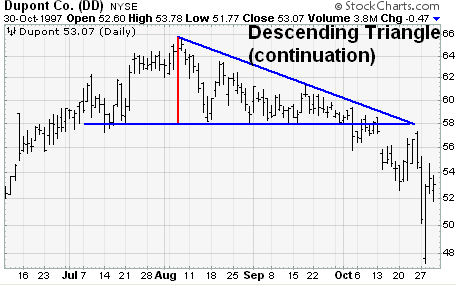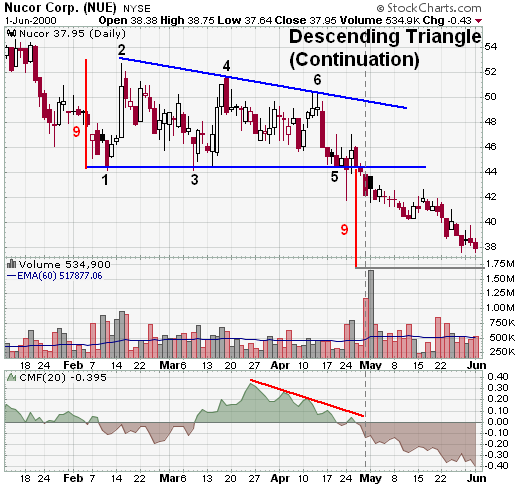Descending triangle is a bearish formation that usually forms during a downtrend as a continuation pattern. There are instances when descending triangles form as reversal patterns at the end of an uptrend, but they are typically continuation patterns. Regardless of where they form, descending triangles are bearish patterns that indicate distribution.

Characteristics of a Descending Triangle
Because of its shape, the pattern can also be referred to as a right-angle triangle. Two or more comparable lows form a horizontal line at the bottom. Two or more declining peaks form a descending trend line above that converges with the horizontal line as it descends. If both lines were extended right, the descending trend line could act as the hypotenuse of a right triangle. If a perpendicular line were drawn extending up from the left end of the horizontal line, a right triangle would form. Let’s examine each individual part of the pattern and then look at an example.
- There should be an existing trend.
To qualify as a continuation pattern, an established trend should exist. However, because the descending triangle is definitely a bearish pattern, the length and duration of the current trend is less important than the robustness of the formation. - Lower horizontal line.
At least two reaction lows are required to form the lower horizontal line. The lows do not have to be exact but should be within a reasonable proximity. There should be some distance separating the lows and a reaction high between them. - Upper descending trend line.
At least two reaction highs are required to form the upper descending trend line. These reaction highs should be successively lower and there should be some distance between the highs. If a more recent reaction high is equal to or greater than the previous reaction high, then the descending triangle is not valid. - Pattern duration.
The length of the pattern can range from a few weeks to many months, with the average pattern lasting from one to three months. - Volume should decrease.
As the pattern develops, volume usually contracts. When the downside break occurs, there would ideally be a volume expansion for confirmation. While volume confirmation is preferred, it isn’t always necessary. - Return to breakout.
A basic tenet of technical analysis is that broken support turns into resistance and vice versa. When the horizontal support line of the descending triangle is broken, it turns into resistance. Sometimes there will be a return to this newfound resistance level before the down move begins in earnest. - Calculating a price target.
Once the breakout has occurred, the price projection is found by measuring the widest distance of the pattern and subtracting it from the resistance breakout.
It’s as if a large buy order has been placed at this level, and it’s taking a number of weeks or months to execute, thus preventing the price from declining further. Even though the price doesn’t decline past this level, the reaction highs continue to decline. It’s these lower highs that indicate increased selling pressure and give the descending triangle its bearish bias.

After recording a lower high just below 60 in Dec-99, Nucor formed a descending triangle early in 2000. In late April, the stock broke support with a gap down, sharp break, and increase in volume to complete the formation.
- The stock declined from above 60 to the low 40s before finding some support and mounting a reaction rally. The rally stalled just below 50, and a series of lower reaction highs began to form. The long-term trend was down, and the resulting pattern was classified as a continuation.
- Support at 45 was first established with a bounce in February. After that, the stock touched this level twice before breaking down. After the second touch in March (about a month later), the lower support line was drawn.
- After each bounce off of support, a lower high formed. The reaction highs at points 2, 4, and 6 formed the descending trend line to mark the potential descending triangle pattern. Why potential? It’s because the pattern isn’t complete until support is broken.
- The duration of the pattern was a little less than three months.
- The last touch of support at 45 occurred in late April. The stock spiked down through support but closed above this key level. The final break occurred a few days later with a gap down, a considerable black candlestick, and an expansion in volume. The way support is broken can offer insight into the general weakness of a security. This wasn’t a slight break but a rather convincing break. Volume jumped to the highest level in many months, and money flows broke below -10%.
- After falling from 45 to 41, the stock mounted a feeble reaction rally that only lasted three days and produced two candlesticks with long upper shadows. Sometimes there’s a test of the newfound resistance level, and sometimes there isn’t. A weak test of support can indicate acute selling pressure.
- The initial decline was projected to be nine points (54 -45 = 9). If this is subtracted from the support break at 45, the downside projection is around 36. Even though the stock exceeded this target in late June, recent strength has brought it back near 36. Targets are only meant to be used as guidelines; other aspects of technical analysis should also be employed for deciding when to cover a short or buy.
Final Thoughts
When the pattern’s breakout occurs, it’s usually indicative of a bearish move. The breakout’s direction and price projection, determined by the widest distance of the pattern subtracted from the resistance breakout, can serve as a crucial guideline. However, this target isn’t absolute and should be used with other technical analysis tools.
Last but not least, it’s important to note that a descending triangle carries a distinct bearish bias, unlike the symmetrical triangle, which remains neutral until the breakout. This bias is highlighted by the pattern’s lower highs, which reflect increasing selling pressure. In short, the descending triangle is an easily recognized pattern that can provide you with valuable insights into an asset’s forthcoming price movements.
Source: StockCharts
(Only the headline and picture of this report may have been reworked by the ShareMantras staff; the rest of the content is auto-generated from a syndicated feed.)